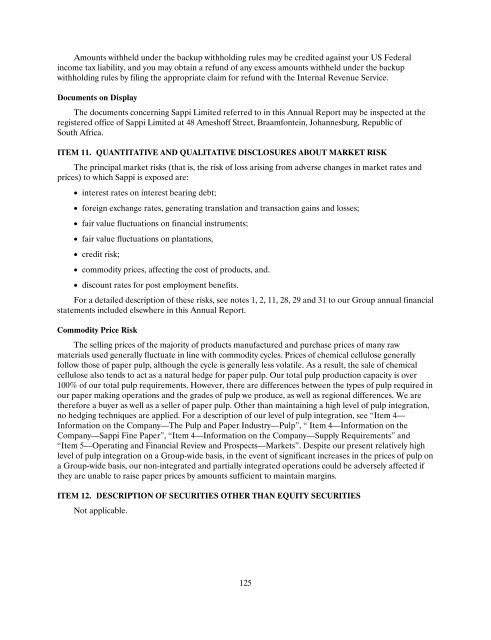Create successful ePaper yourself
Turn your PDF publications into a flip-book with our unique Google optimized e-Paper software.
Amounts withheld under the backup withholding rules may be credited against your US Federal<br />
income tax liability, and you may obtain a refund of any excess amounts withheld under the backup<br />
withholding rules by filing the appropriate claim for refund with the Internal Revenue Service.<br />
Documents on Display<br />
The documents concerning <strong>Sappi</strong> Limited referred to in this Annual Report may be inspected at the<br />
registered office of <strong>Sappi</strong> Limited at 48 Ameshoff Street, Braamfontein, Johannesburg, Republic of<br />
South Africa.<br />
ITEM 11. QUANTITATIVE AND QUALITATIVE DISCLOSURES ABOUT MARKET RISK<br />
The principal market risks (that is, the risk of loss arising from adverse changes in market rates and<br />
prices) to which <strong>Sappi</strong> is exposed are:<br />
• interest rates on interest bearing debt;<br />
• foreign exchange rates, generating translation and transaction gains and losses;<br />
• fair value fluctuations on financial instruments;<br />
• fair value fluctuations on plantations,<br />
• credit risk;<br />
• commodity prices, affecting the cost of products, and.<br />
• discount rates for post employment benefits.<br />
For a detailed description of these risks, see notes 1, 2, 11, 28, 29 and 31 to our Group annual financial<br />
statements included elsewhere in this Annual Report.<br />
Commodity Price Risk<br />
The selling prices of the majority of products manufactured and purchase prices of many raw<br />
materials used generally fluctuate in line with commodity cycles. Prices of chemical cellulose generally<br />
follow those of paper pulp, although the cycle is generally less volatile. As a result, the sale of chemical<br />
cellulose also tends to act as a natural hedge for paper pulp. Our total pulp production capacity is over<br />
100% of our total pulp requirements. However, there are differences between the types of pulp required in<br />
our paper making operations and the grades of pulp we produce, as well as regional differences. We are<br />
therefore a buyer as well as a seller of paper pulp. Other than maintaining a high level of pulp integration,<br />
no hedging techniques are applied. For a description of our level of pulp integration, see “Item 4—<br />
Information on the Company—The Pulp and Paper Industry—Pulp”, “ Item 4—Information on the<br />
Company—<strong>Sappi</strong> Fine Paper”, “Item 4—Information on the Company—Supply Requirements” and<br />
“Item 5—Operating and Financial Review and Prospects—Markets”. Despite our present relatively high<br />
level of pulp integration on a Group-wide basis, in the event of significant increases in the prices of pulp on<br />
a Group-wide basis, our non-integrated and partially integrated operations could be adversely affected if<br />
they are unable to raise paper prices by amounts sufficient to maintain margins.<br />
ITEM 12. DESCRIPTION OF SECURITIES OTHER THAN EQUITY SECURITIES<br />
Not applicable.<br />
125
















